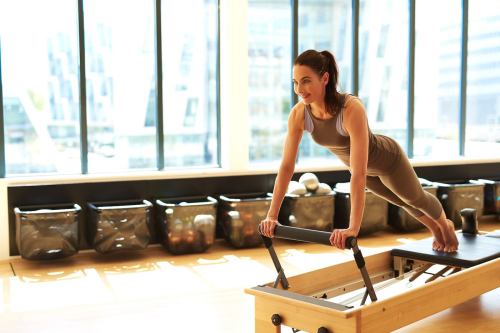A *lot* of people are ditching bootcamps for Pilates—and there’s a science to why
There's a reason why it's gotten so much harder to get a machine at your local SLT studio: Pilates on a reformer is more popular than ever.

In 2020, Pilates will celebrate its 94th birthday. It’s the OG boutique fitness class, and Joseph Pilates’ 34 original exercises set the stage for a number of other workouts, like barre and Megaformer (which BTW: was one of our 2020 Trends) to become mainstays for those with stacked studio fitness calendars. Nearly a century after its advent, people (particularly women) are trading their sneakers and HIIT workouts for grippy socks, as Pilates has proven to be more popular than ever.
According to a 2019 survey from MINDBODY, the modality ranked among respondents’ top choice for “what to try next,” and a third of those surveyed said they were looking to start doing Pilates. But they won’t be the only newbies in class: Nearly half (48 percent) of people currently practicing Pilates have only started taking classes within the last 12 months.
Across the country, studios are seeing the effects of this increased interest. In early 2015, Club Pilates had only 30 studios—at the end of 2019, there were 650. Elaine Hayes, founder of MNTSTUDIO Pilates in San Francisco, says that she saw business increase 25 percent last year, and is opening a second location in Palo Alto in 2020. “My business is better than ever,” she told Well+Good. “I’m starting to see more and more people flock to reformer classes.”
But what is it that’s sending so many people to the chair, mat, reformer, box, and tower? In a word: burnout.
Forty-eight percent of people have reported an increase in stress over the past five years, and young women tend to be most burdened by it. Pilates may offer a way to counter that. “Reformer Pilates addresses the body and mind as a whole using precise, well-aligned, and ergonomic movements and poses to tone, lengthen, and challenge the body,” said Hayes. “By incorporating mindfulness, breath, and fluid movement, the body is brought into a place of ease.” MINDBODY’S survey asked people why they chose Pilates over other exercises, and 51 percent of reformer fans called out “self care,” while 47 percent see the practice as a way to destress.
Science offers a good reason why people might feel this way about their Pilates practice. A 2008 study from the Journal of Endocrinological Investigation showed that “moderate to high intensity exercise provokes increases in circulating cortisol levels,” but low intensity exercise “resulted in a reduction in circulating cortisol levels.” It’s not just mental stress that has people hopping on the reformer in lieu of their HIIT classes. Physical stress, a common side effect of overtraining or pushing your body too hard, is also driving people to look for a lower-impact option from their workouts. “I think as millennials begin to age, we are starting to understand that we’re not going to be young forever, and beating our bodies up is not sustainable,” says Hayes.
While there are definite benefits to training at high intensity, it’s important to ensure that your body can keep up with those sorts of workouts—and that’s where Pilates comes in. “The emphasis on core control and slow, controlled contractions through full joint ranges of motion is why I believe Pilates is powerful for injury risk reduction,” says injury prevention specialist Liz Letchford, PhD-C and founder of The Release. “I recommend prioritizing mobility, recovery and gradual strength training, and Pilates is a great way to practice the fundamentals that are imperative to building a strong, healthy body.”
So the combination of a stressed-out country and a good handful of years overdoing it on the cardio trend (at least in major metros) have led people into Pilates studios, but what’s gotten them to stay? According to MINDBODY, 70 percent of people who do Pilates are returning to their studios multiple times a week. “Classes are by no means easy—you will sweat and shake from head to toe” said Hayes. “But rather than shock the body through a high-impact workout, Pilates works with the body for long-lasting, incredible results.” Pilates has long been the holy grail of studio workouts, and clearly, it isn’t going anywhere, any time soon.
Ready to get started, but aren’t by a Reformer? Try this Pilates full-body workout:
Three of our editors committed to three months of reformer workouts, and the experience was completely different for all of them. And if you can’t make it into the studio, these floor moves are basically the same as having a reformer at home.
Sign Up for Our Daily Newsletter
Get all the latest in wellness, trends, food, fitness, beauty, and more delivered right to your inbox.
Got it, you've been added to our email list.










